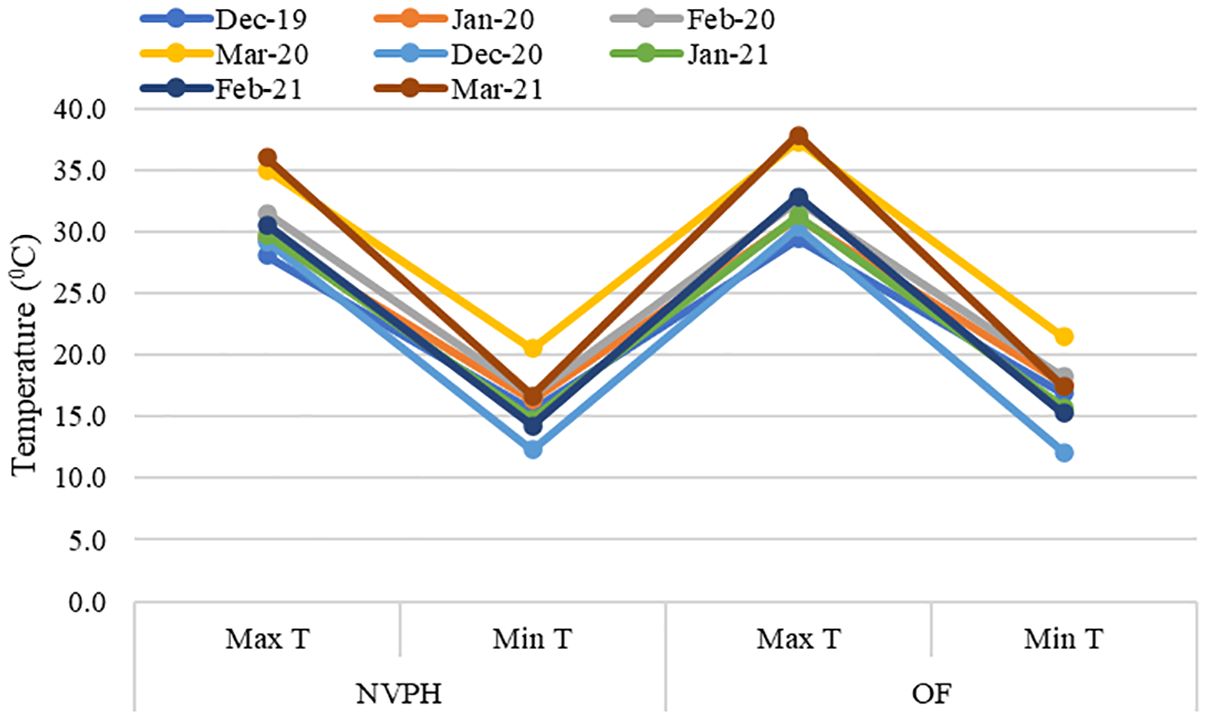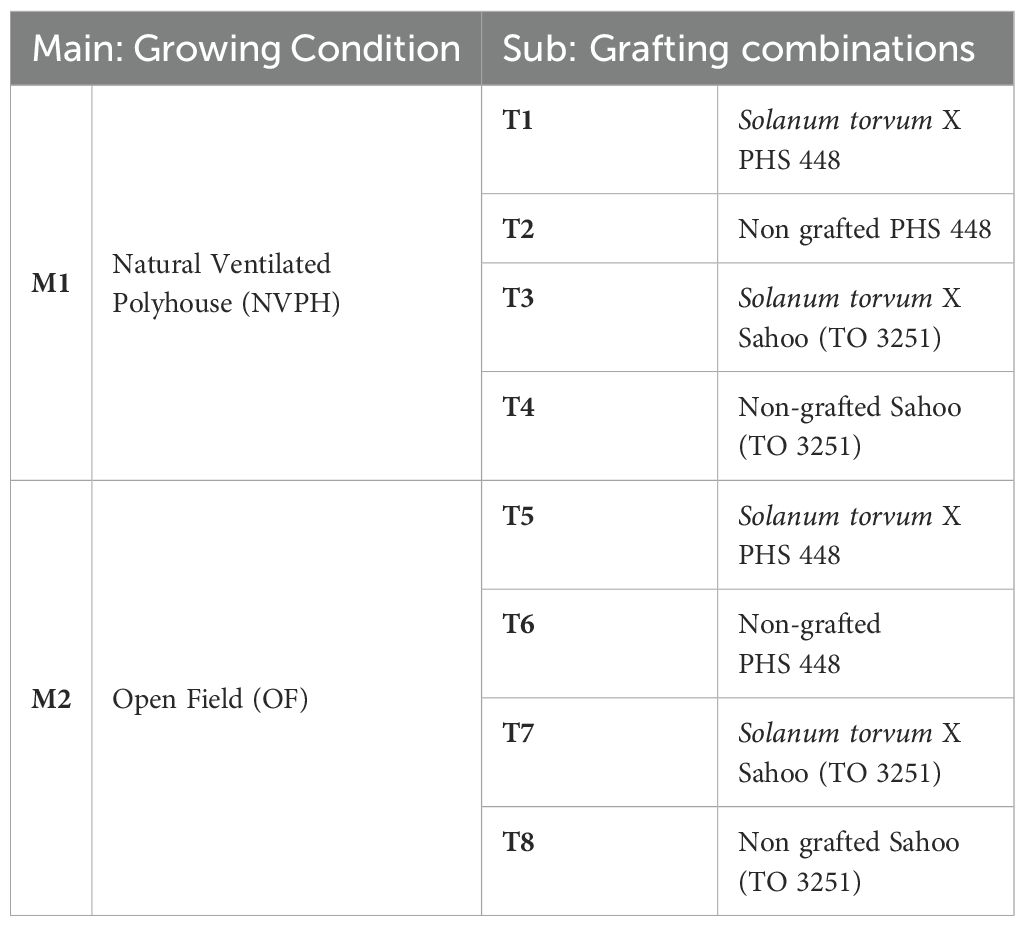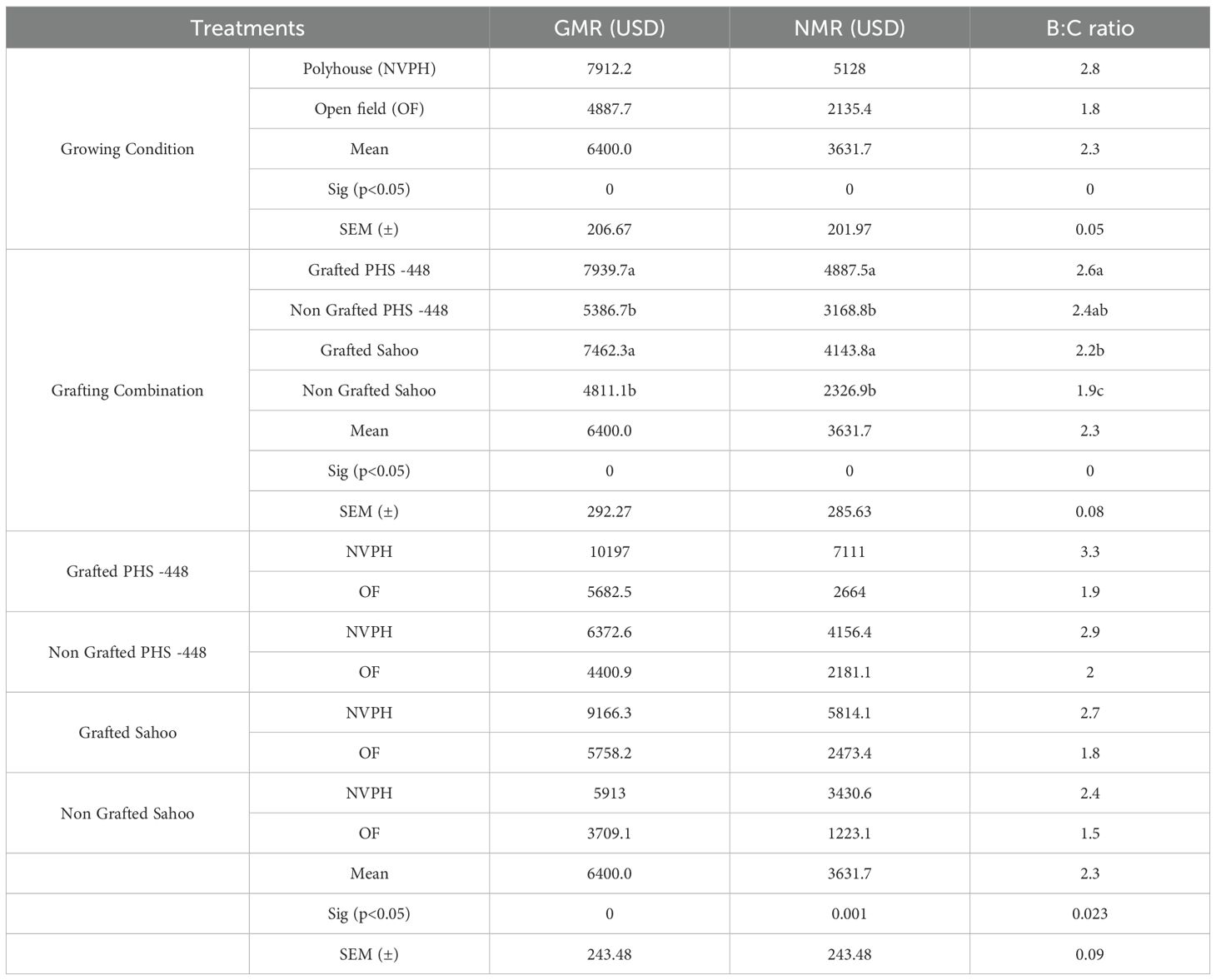- 1International Crops Research Institute for the Semi-Arid Tropics (ICRISAT), Hyderabad, Telangana, India
- 2Heirloom Seedlings and Plants Private Ltd., Vijayawada, Andhra Pradesh, India
Introduction: Vegetable grafting is a recent innovation in vegetable cultivation that has a great potential for enhancing crop productivity and profitability under climate change scenarios, besides its potential to reduce the cost of cultivation.
Methods: The present strategic research focused on assessing the performance of grafted and non-grafted tomato cultivars (PHS-448 & Sahoo) in Naturally Ventilated Polyhouse (NVPH) and open field (OF) conditions.
Results and discussion: The results revealed that grafted tomatoes expressed significantly (p<0.05) higher values of growth parameters, i.e., leaf area and chlorophyll content, contributing to significantly higher total yield over non-grafted tomatoes. The grafted tomato cultivars, viz, PHS-448 and Sahoo, recorded an increased total yield of 36.65% and 46.7% respectively compared to the non-grafted ones. Growing grafted tomatoes under NVPH conditions increased yields by 63.79% due to an increase in pickings (by 3 to 5 times) compared to non-grafted tomatoes grown under open field conditions. The system productivity followed similar yield trends and revealed significant (p<0.05) variation across all picking days. The profitability analysis (gross and net monetary returns and benefit-cost ratio) showed that grafted combinations grown under NVPH are more profitable than the open field conditions and non-grafted ones, grown under both conditions. The multiple regression analysis revealed a strong correlation (R2= >80) of yield with plant height, middle leaves chlorophyll, and leaf area, irrespective of the grafted and non-grafted combinations. The present investigation concluded that cultivating grafted tomatoes helps farmers achieve maximum productivity and profitability in both NVPH and open field conditions. However, a proper policy framework is necessary to promote and scale up grafted vegetable technology to enhance the profitability of vegetable growers in climate change scenarios.
1 Introduction
Tomato (Lycopersicon esculentum Mill.) is one of the most widely cultivated vegetable crops and plays an important role in vegetable production in the world. Tomatoes, also known as poor man’s orange, are a well-liked, nutrient-dense vegetable having a great source of vitamin C (Pal et al., 2023), minerals, proteins, essential amino acids (leucine, threonine, valine, histidine, lysine, and arginine), mono-unsaturated fatty acids, carotenoids, and phytosterols (Ali et al., 2021). In 2022, the world produced 254.44 million tons of tomatoes from 6.06 million hectares of land, yielding a productivity of 41.99 tons per hectare. China is the leading producer of tomatoes worldwide with a share of 26.85% (68 million tons), followed by India with 8.13% (20.57 million tons) share of the world’s total production. In India, the area, yield, and productivity of tomato was 0.84 million hectares, 20.64 million tons, and 24.64 tons/ha, respectively, in 2020–21 (FAO, 2022). It is widely grown in most Indian states, where Madhya Pradesh ranks first, followed by Andhra Pradesh in the production of tomatoes (Anonymous, 2022). Nevertheless, there are numerous obstacles to this crop’s production, such as biotic and abiotic stresses, which lower the crop’s yield. Public and corporate sectors are working to develop tomato cultivars at their best under constrained circumstances using breeding and biotechnology, though these efforts take a lot of time. Consequently, there are chances to increase tomato productivity by using novel technology like grafting, which is a viable method to increase a tolerance to a wide range of environmental conditions and has been the subject of numerous studies (Kumar et al., 2023).
Grafting is a plant propagation technique wherein two different plants are joined together to continue their growth as a single plant and used explicitly in woody plants (Eliezer, 2014). This can be a positive tool for a quick alternative to the socio-economic issues of genetically modified food and the relatively slow breeding methods aimed at improving fruit quality combined with increased productivity and extended shelf life (Nkansah et al., 2013; Musa et al., 2020). Vegetable grafting has the potential to boost the growth and development, nutrient uptake, tolerance to salinity and thermal stress, and can reduce viral, fungal, and bacterial infections and thereby increasing the production of vegetables of Solanaceous and Cucurbitaceous crops in many countries, primarily associated with incurring consequences of intensive cultivation (Rivero et al., 2003; Lee et al., 2010; Bie et al., 2017; Coskun, 2023).
The production of vegetables is significantly impacted by the effect of climate change. In particular, rising temperatures have a direct effect on their yield (Dumitru et al., 2023). Other limiting factors, such as availability of water, nutrients, quality, and quantity of light, must be considered to provide appropriate conditions for the optimal growth and development of the crop. Tomato production has undergone many changes in the way it is grown in different regions, both in open fields and in protected cultivation. Controlled environment agriculture, sometimes referred to as protected farming, is a very productive method that conserves water and land while simultaneously safeguarding the environment (Jensen, 2002), where several parameters like temperature, humidity, light, soil, water, and fertilizers are adjusted to maximize yield during the off-season. Compared to plants grown in the field conditions, those grown in the polyhouse results in significantly higher quality attributes such as chlorophyll a, chlorophyll b, total chlorophyll, reducing sugar and non-reducing sugar (Thapa et al., 2013).
Thus, the present study was undertaken at the Research Farm at ICRISAT, India, to comprehend the performance of grafting in tomatoes in enhancing growth, production, and profitability under open and protected conditions.
2 Materials and methods
2.1 Description of the study area
The experiment was conducted at the research station at the International Crops Research Institute for the Semi-Arid Tropics (ICRISAT), Patancheru, Hyderabad (17°29’21.23”N, 78°16’40.82”E). Which comes under semi-arid tropical climatic conditions in India, receiving an average annual rainfall around 800 mm. The experiment was carried out during the rabi season of 2019 and 2020 in Naturally Ventilated Polyhouse (NVPH) and Open Field (OF) conditions. Weather parameters viz. light, temperature, and humidity were maintained naturally in the NVPH structure and these parameters were monitored in the both the conditions using an Automatic Weather Station. The average minimum temperature ranged between 12.3-20.5°C and 12.1- 21.4°C, whereas the maximum temperature ranged between 28.0-36.0°C and 29.4- 37.8°C during cropping seasons in NVPH and Open field conditions respectively (Figure 1). The experimental soils in both the conditions were neutral in nature, low in soil organic carbon, medium in phosphorus and potassium with sufficient micronutrients and secondary nutrients, except sulphur.
2.2 Seedling production
Splice grafting was adopted in the present investigation which is one of the most standard and successfully adopted technique for grafting in solanaceous crops. This technique is easy to perform, ensures quick graft healing, and results in a higher success rate, especially in tomato (Pardo-Alonso et al., 2020; Chandanshive et al., 2023). The eggplant species, Solanum torvum, native to India, is one of the compatible rootstocks for interspecific grafting with tomato. It provides resistance to biotic and abiotic stresses and help enhancing the production of solanaceous crops. Considering these advantages, we used this species as a rootstock for grafting with tomato scion cultivars, i.e. PHS 448 and Sahoo (TO 3251) in the study. Seeds of S. torvum takes longer time for germination and thus sown 15 days earlier in pro-trays filled with cocopeat and compost than scion varieties to ensure similar stem diameter at the time of grafting (Petran and Hoover, 2014). Grafting was performed when scion seedlings were 16-20 days old and the rootstock of 35-40 days old (Shipepe and Msogoya, 2018). Grafting was performed manually by cutting the stem of rootstock and scion at 45° angles in opposite directions and joined using silicon grafting tubes. Post grafting, the seedlings were placed in a healing chamber for 6-7 days followed by hardening in semi-shed conditions for 5 days, before transplanting (Petran, 2013).
2.3 Treatment details
The details of the treatments considered under different growing conditions and different grafting combinations have been provided in the Table 1.
2.4 Plant management
The seedlings of grafted and non-grafted tomatoes, in both NVPH and OF, were transplanted at a spacing of 60 x 45 cm in a paired row on the raised beds of 90 cm width. Irrigation was provided using a drip irrigation system having an emitter discharge rate of 4 liter per hour for 20-40 minutes depending upon crop growth stage and season. Plants were irrigated weekly twice in the early stages of growth whereas the frequency of irrigation was increased to an alternate day when temperatures started rising, especially in early summer. Fertilizers dose of 150:110:150 kg NPK per hectare was applied in the present experimentation. Depending upon the crop growth stage, water-soluble fertilizers of different grades of NPK, like 19:19:19, 13:00:45, and CaNO3 (15.5% N and 18.5% Ca) were injected through the fertigation system at the weekly intervals, starting from 15 days after transplanting (DAT). These fertilizer grades have higher nutrient use efficiency, preferred by farmers and are readily available in the markets. Four hand weedings were carried out during the crop cycle to control the weed infestation in the field.
2.5 Data recording
Plant height at every 30-day interval of transplanting was measured at different growth stages of the crop using a metric scale. SPAD 502 (Soil Plant Analysis Development) meter of Konica Minolta, provides quick estimation of chlorophyll content (Perez-Patricio et al., 2018) and was used to determine the chlorophyll content of the leaves. Since the plant and leaf age are important factors and contribute in determining the photosynthetic and phototropic traits (Bielczynski et al., 2017), leaves from the plants’ bottom, middle, and top branches at 30 days intervals were sampled separately for understanding the assimilation patterns of chlorophyll in older and new leaves during the different crop growth stages (Kamble et al., 2015). Leaf area was measured using a LICOR LI-3100C meter, which quickly records and computes the area of individual leaves (Posse et al., 2009). Fruits were harvested at the marketable maturity stage, and yield was recorded at weekly interval in kg/ha. The System Productivity (kg/ha/day) of tomato referring to the yield at different harvesting days was calculated by dividing the total cumulative yield (kg/ha) with the crop duration (days).
2.6 Statistical analysis
The data collected from two years of study, i.e., 2019 and 2020, were subjected to statistical analysis with ANOVA to test the least significant difference of treatment means at a 5% level using the SPSS 17.0 version statistical package. A linear regression test was performed to understand the relationship of growth parameters with yields under grafted and non-grafted scenarios using R software.
3 Results
3.1 Plant height under different growing conditions and grafting combinations
Tomato plant height was significantly (p<0.05) influenced (Figure 2a) under both the growing condition and grafting combinations. As recorded, the plant height increased with the days (ranging from 33.6 cm on 30 DAT to 96.2 cm on 120 DAT) irrespective of the growing condition and grafting combination. Growing tomatoes under the NVPH condition resulted in maximum plant height (94.6 cm at 120 DAT) compared to open field (84.5 cm at 120 DAT). In the case of grafted and non-grafted tomato cultivars, the non-grafted plants showed the highest plant heights compared to grafted ones. Among the four combinations, the non-grafted Sahoo tomato cultivar recorded the highest plant height (96.2 cm), while the grafted PHS-448 recorded the lowest (82.6 cm) plant height at day-120. However, in the interaction effect, a significant variation (p<0.05) in the plant height of the tomato was noticed only at 30 DAT. The non-grafted Sahoo cultivar grown under polyhouse conditions and non-grafted PHS-448 grown under field conditions recorded maximum heights at 30 DAT (Figure 2a).
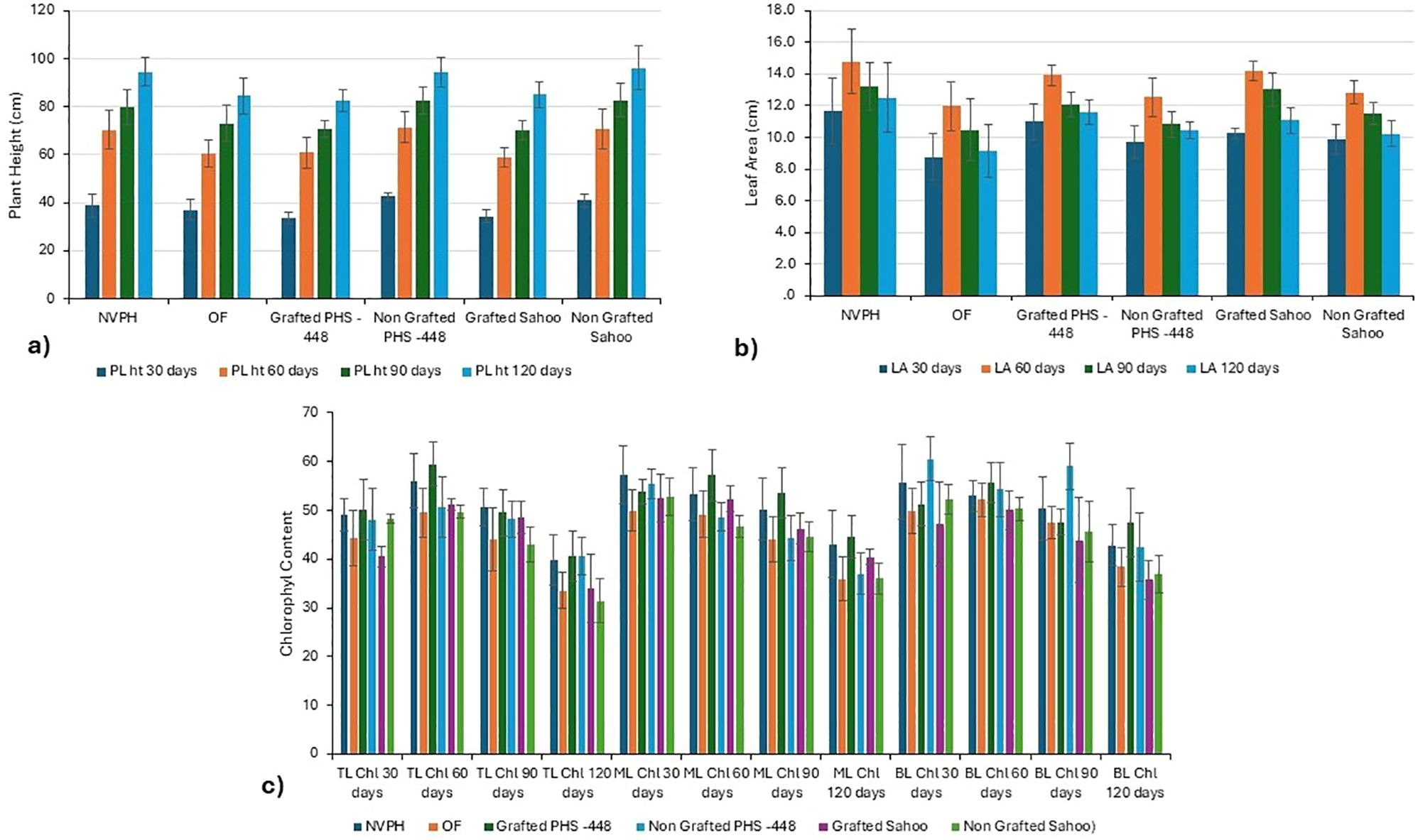
Figure 2. Effect of growing conditions and grafting combinations on plant height (a), leaf area (b) and chlorophyll content (c) in tomatoes.
3.2 Leaf area under different growing conditions and grafting combinations
The study revealed a significant (p<0.05) effect of both the growing conditions and grafting combinations on the leaf area of tomato plants (Figure 2b). The values of leaf area ranged from 8.4 to 15.8 cm2 in the present study. The highest leaf area was observed between 60 and 90 DAT. As recorded, the leaf area values were maximum in the tomato plants that grew under the NVPH condition (13.2 cm2 at 90 DAT) compared to the field condition (12.0 cm2 at 60 DAT). When we studied the impact of grafting and non-grafting on leaf area of tomato cultivars, the grafted cultivars showed the highest leaf area compared to non-grafted ones. Specifically, the grafted Sahoo showed a maximum leaf area (14.2 cm2), followed by the grafted PHS -448 (13.9 cm2) at 60 DAT (Figure 2b).
3.3 Chlorophyll content under different growing conditions and grafting combinations
The present study revealed a significant (p<0.05) variation in the chlorophyll content of the tomato under both the growing condition and grafting combination (Figure 2c). Maximum chlorophyll content was recorded in the early growing stages, i.e., up to 90 DAT. Later, it decreased over time in top, middle, and bottom leaves. The chlorophyll values ranged from 38.5 to 62.6 in the top leaves, 49.2 to 60.0 in the middle leaves, and 45.3 to 61.8 in the bottom leaves. It was recorded that growing tomatoes under NVPH condition resulted in significant (p<0.05) maximum chlorophyll content as compared with open field. The highest chlorophyll content of tomato leaves i.e. 56.0, 57.3, and 55.7 were recorded in the top leaves at 60 DAT, middle leaves at 30 DAT, and bottom leaves at 60 DAT under NVPH condition. In case of grafting combinations, grafted PHS-448 showed the highest chlorophyl content i.e. 59.5, 57.2, and 55.7 in the top, middle and bottom leaves respectively, at 60 DAT (Figure 2c). However, the interaction effect showed significant variations in chlorophyll content in the top leaves at 60 and 90 DAT. A significantly higher chlorophyl content (62.6) was recorded in the grafted PHS-448 at 60 DAT followed by grafted Sahoo the (56.8) at 90 DAT in top leaves under polyhouse condition.
3.4 Tomato yield under different growing conditions and grafting combinations
Tomato plants grown under NVPH condition substantially yielded up to 13th picking (171 DAT); however, they yielded up to 11th picking (155 DAT) under the field condition. This outcome has demonstrated that tomato yields can be better when grown under the polyhouse condition than the field condition. In the present research, maximum tomato yields were obtained between the 3rd (91 DAT) and 8th pickings (131 DAT) (Table 2), and it started decreasing over the later stages of pickings, i.e., from the 9th (139 days) to the 13th (171 DAT). However, a significantly (p<0.05) highest tomato yield (6.20 t/ha) was noted in the case of NVPH followed by the highest value of 5.03 t/ha in the field condition at 6th picking (115 DAT). Overall, growing tomatoes under the polyhouse condition increased the total yield by 50.59% (50.56 t/ha) over the field condition (33.60 t/ha).
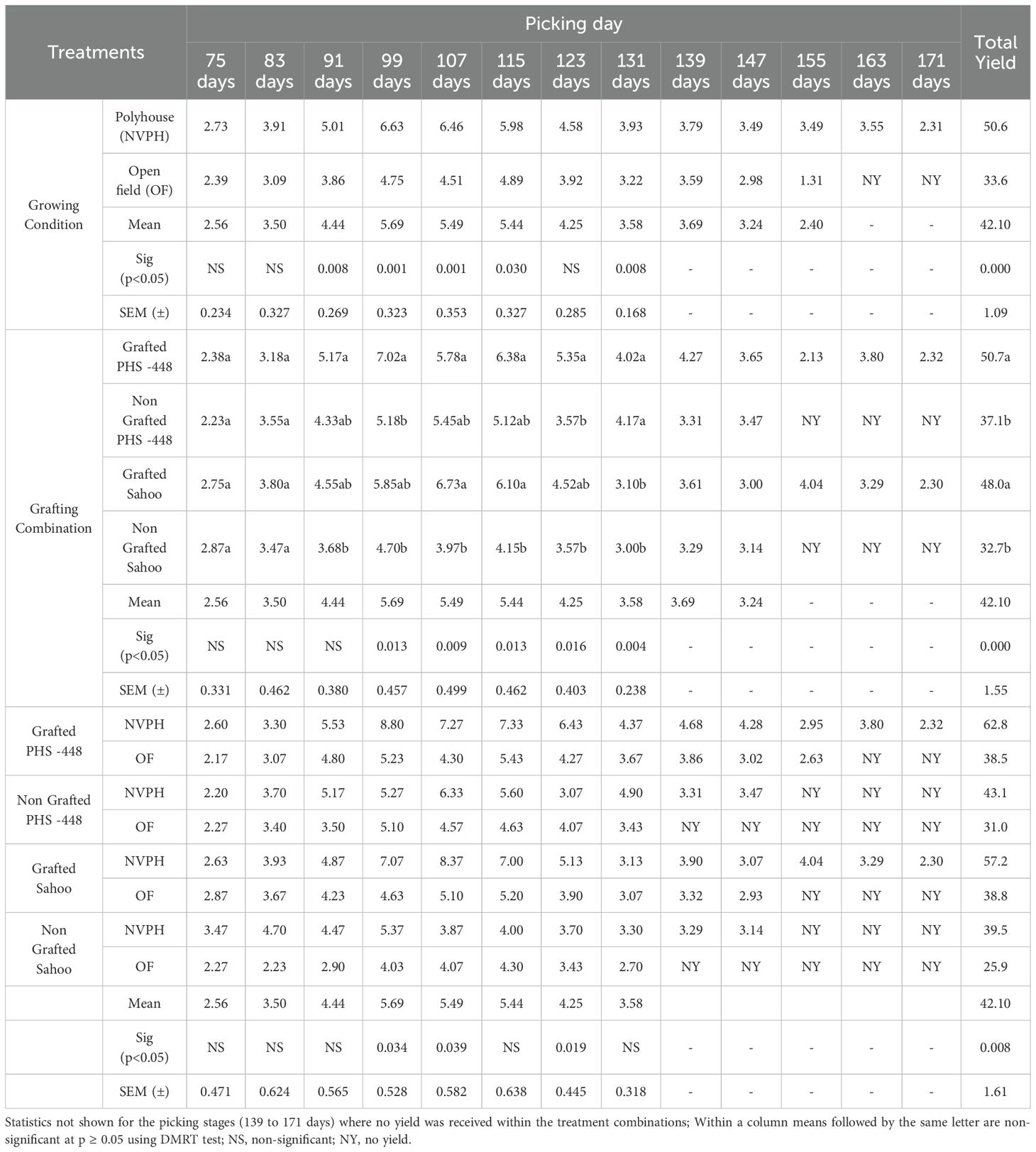
Table 2. Tomato yield (t/ha) at different picking days as affected by various growing conditions and grafting combinations.
In the case of the different grafting combinations, it was found that both the grafted tomato cultivars, i.e., grafted PHS-448 and grafted Sahoo, produced yields up to 13th picking (171 days), while the Non grafted tomato cultivars, yielded up to 10th picking (147 DAT) (Table 2). This signifies the practical utility of grafting in tomatoes to enhance the number of pickings over non-grafted plants. The significant (p<0.05) highest yield of tomato, i.e., 6.83 t/ha, was recorded under the grafted PHS-448 at 4th picking (99 DAT), followed by 6.73 t/ha in the grafted Sahoo at 5th picking (107 DAT) (Table 2). However, the lowest tomato yield (2.23 t/ha) was recorded in the non-grafted PHS-448 at 1st picking (75 DAT). Overall, the grafted PHS-448 increased the total yield by 36.65% (50.7 t/ha) over the non-grafted PHS-448 (37.1 t/ha), while the grafted Sahoo increased the total yield by 46.7% (48.0 t/ha) against the non-grafted Sahoo (32.7 t/ha).
The interaction effect of growing conditions and grafting combinations showed significant (p<0.05) tomato yields only at 4th, 5th, and 7th pickings (Table 2). The grafted PHS-448 resulted significantly highest yield (62.8 t/ha), followed by the grafted Sahoo (57.2 t/ha) under the NVPH condition. The interaction study comprehended that both the cultivars grown under NVPH conditions yielded more compared to open field condition. Hence, the results from the present research showed that grafting tomato seedlings and growing them under NVPH conditions can substantially increase the yields by enhancing the number of pickings by 3 to 5, which is a novel observation from this study. We further computed the average total yield and the percent yield increase in grafted tomatoes (cultivars in place of varieties) over control (non-grafted plants grown under open fields) under polyhouse and open conditions (Figure 3). It was observed that growing grafted tomato plants under NVPH conditions can increase yields by 63.79% as compared to non-grafted ones under open field conditions.
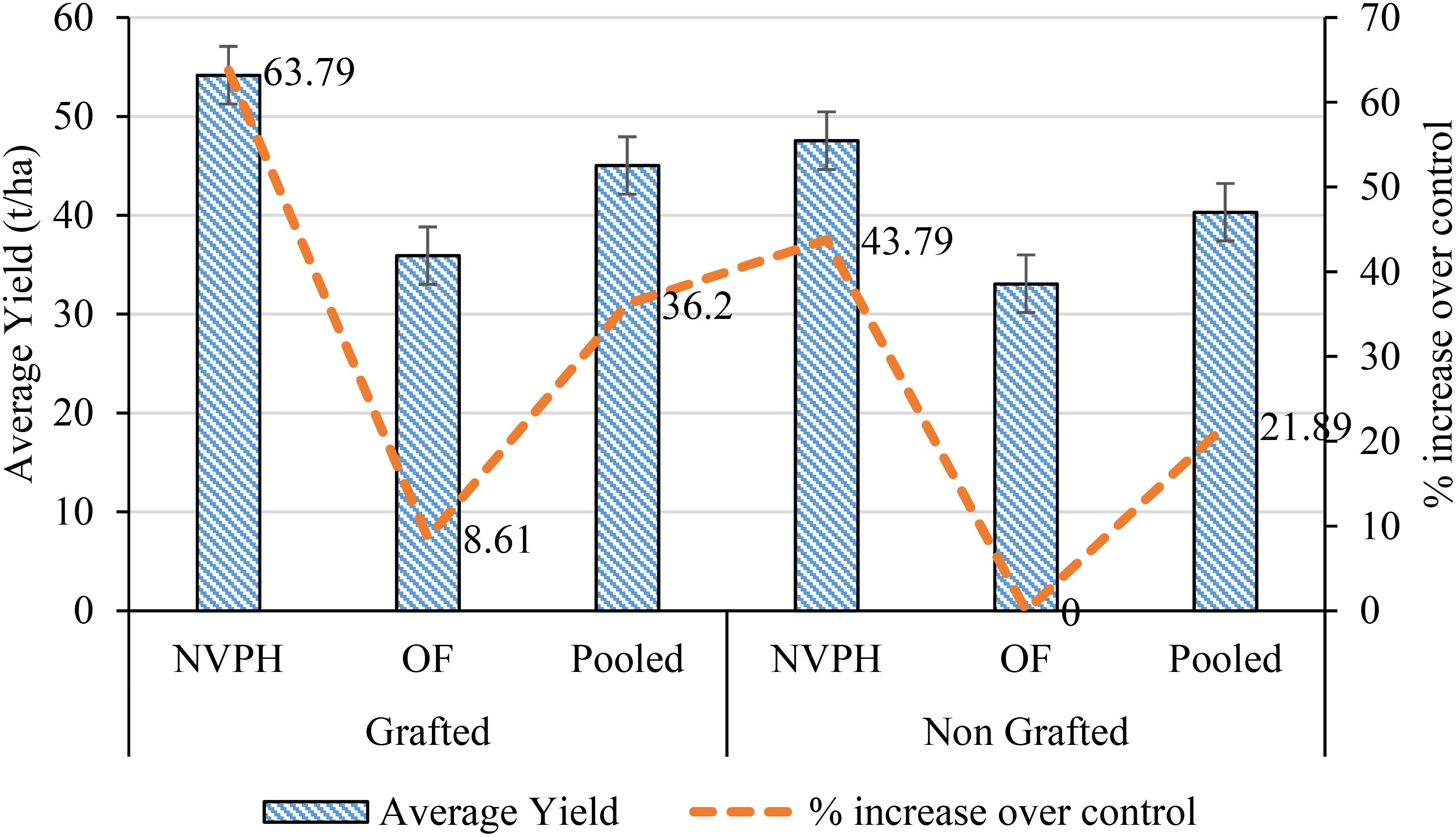
Figure 3. Average yield of tomatoes under polyhouse and open field conditions. Non-grafted under open field condition considered as control.
3.5 Economics of grafted vs non grafted tomato cultivation
The significant (p<0.05) increase in gross monetary returns (by 61.88%), net monetary returns (by 140.14%), and B:C ratio (by 55.56%) were noticed in the NVPH growing condition over the open field (Table 3). Under the grafted combinations, both the tomato cultivars i.e. PHS-448 and Sahoo recorded more gross returns (by 47.39 and 55.11%), net returns (by 54.24 and 78.08%), and benefit-cost ratio (by 8.33 and 15.79%) against the non-grafted PHS-448 and non-grafted Sahoo, respectively. From the interaction effect, it was confirmed that grafted cultivars PHS-448 and Sahoo grown under NVPH were significantly (p<0.05) profitable than the non-grafted ones grown both in NVPH and open field conditions.
3.6 System productivity of grafted vs non grafted tomato cultivation
The system productivity of tomatoes at different picking days as affected by various growing conditions and grafting combinations have been illustrated in Table 4. Though the system productivity followed a similar trend as observed in the case of yields, it unveiled some interesting findings when the system productivity was considered on a daily basis. The significantly (p<0.05) highest system productivity (312.18 kg/ha/day) was recorded in the NVPH, followed by open field (135.82 kg/ha/day) at 10th picking (147 DAT). Both the grafted tomato cultivars, i.e., PHS-448 and Sahoo, showed maximum system productivity at all the picking days as compared to non-grafted ones. However, the significant (p<0.05) highest system productivity of 329.72 kg/ha/day and 290.70 kg/ha/day was recorded in the grafted PHS-448 and grafted Sahoo, respectively, at 11th and 10th picking. Similar to the trend noticed in yield, the interaction effect of growing conditions and grafting combinations on tomato system productivity showed significant (p<0.05) effect only at 7th picking (Table 4).
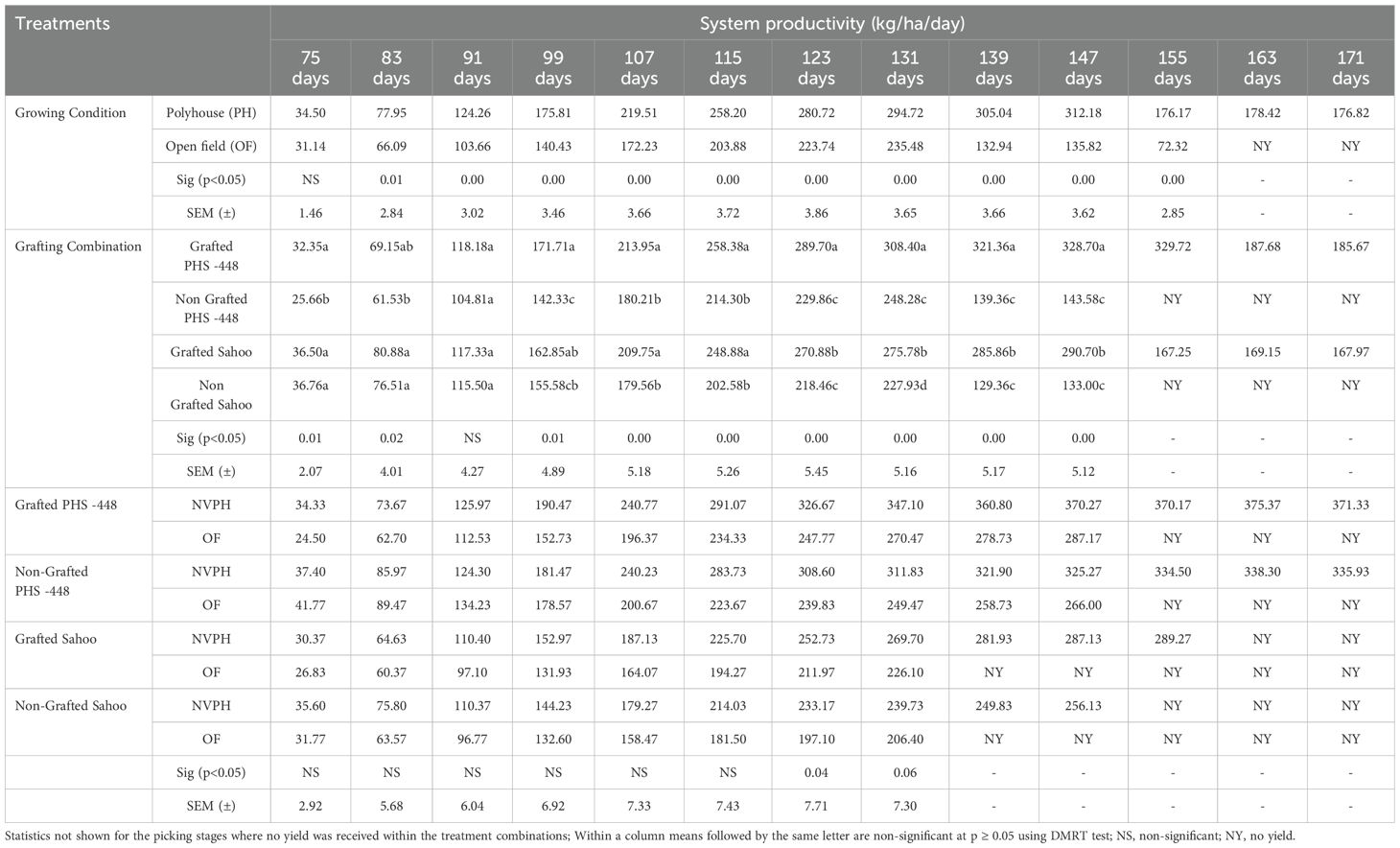
Table 4. System productivity of tomato at different picking days as affected by various growing conditions and grafting combinations.
3.7 Relationship of growth attributes with crop yields in grafted and non-grafted cultivars
Multiple regression analysis of the data concerning grafted and non-grafted situations with yield pickings and at a specific number of days revealed a strong association (Table 5). Under the grafted situation, we noticed a strong association of Middle leaves Chlorophyll (p<0.05) with 1st to 4th and 9th to 13th pickings, respectively. The coefficient of leaf area showed a positive association with yield for 5th to 8th and 9 to 13th pickings. However, the coefficients of plant height and bottom leaves chlorophyll revealed their contribution towards yield positively in the 9th to 13th pickings.
In case of non-grafted situation, we observed that coefficients of top leaves chlorophyll, bottom leaves chlorophyll, and leaf area contributed significantly (p<0.05) towards the yield at 1st to 4th picking (Table 5). The plant height, middle leaves chlorophyll, and leaf area showed a much stronger association with yield when regressed for 9th to 13th picking. Overall, the plant height (X1), middle leaves chlorophyll (X2), and leaf area (X3) variables showed a strong contribution towards tomato yield in grafted and non-grafted combinations at different picking days.
4 Discussion
4.1 Morphological parameters under polyhouse condition and grafting combinations
The current study observed that tomato cultivation in polyhouse conditions helped the morphological characteristics like plant height, leaf area, and chlorophyll content of grafted plants to express better than the open field plants. The warmer environment inside the polyhouse positively favoured morphological development, including plant height and the leaf area index (Miah, 2001; Pandey et al., 2004; Parvej et al., 2010). The results are supported by the findings of Kanwar (2011), which revealed that cultivating tomato varieties viz. Pusa Rohini, PH-5, Shivalik, Jaya, Naveen 2000+ in the NVPH condition produced the mean plant height of 121.4 cm against the plant height of 88.10 cm in open field condition. When comparing the plant heights of grafted and non-grafted tomato cultivars, the non-grafted plants displayed the highest plant heights. Chandanshive et al. (2023) observed that the Phule Kesari variety of tomato when grafted on Solanum torvum rootstock produced lesser height of the plants than the non-grafted tomato plants. Further, the observations reported by Huang et al. (2015) support the results of this study that non-grafted plants of tomato recorded higher plant height compared to the grafted plants. Similarly, Mahbou et al. (2022) reported that non grafted tomato cv. Rio Grande resulted in higher plant height compared to the self-grafted Rio Grande and other grafted combinations of Rio Grande along with Kotobi and Nkeya varieties. The low plant height could be attributed to limited vascular system continuity and few vascular bundles regenerated at the graft union.
In the present study, the grafted cultivars showed the highest leaf area values and chlorophyll content compared to non-grafted ones. The results are in line with the earlier studies by Pugalendhi et al. (2021), Liu et al. (2011), Sun et al. (2002); they noticed that the grafting results in a substantial increase in higher chlorophyll content in Muskmelon, cucumber and pumpkin than the non-grafted ones. The maximum chlorophyll content was observed in the first 90 days of growth and gradually declined in all the upper, middle, and lower leaves due to senescence. When tomatoes grown in a polyhouse condition, the chlorophyll content was significantly higher (p<0.05) than in an open field. Similarly, Kumari et al. (2021) observed that growing bell peppers in polyhouse and open field conditions, increased the mean total chlorophyll content of all hybrid varieties under NVPH conditions (13.79 mg g-1 FW), compared to an open field (11.32 mg g-1 FW). As regards to the cultivars, the grafted PHS-448 showed the maximum chlorophyll content in the top, middle and bottom leaves.
As the temperature increased with the crop stage, the loss in chlorophyll content was observed in both growing conditions. There have also been reports of tomatoes and other crops losing chlorophyll due to high temperatures (Vijayakumar and Beena, 2020). High temperatures change the anatomical structure of leaves, changing the shape of the chloroplasts, swelling of the stromal lamellae, and clumpy vacuoles, resulting in reduced photosynthetic and respiratory activities (Zhang et al., 2005; Lipiec et al., 2013). In general, the higher the chlorophyll content, the higher the rate of photosynthesis, although there may be exceptions to this rule where reduced chlorophyll content has little impact on photosynthesis (Walker et al., 2018). This indicates a greater influx of CO2 into mesophyll cells surrounding chloroplasts and, thereby, a higher photosynthetic rate inside the polyhouse. The present study recorded the highest leaf area values in tomato plants grown under polyhouse over field conditions. Certainly, the warmer environment inside the polyhouse helps in improving the morphological development of the plants, such as plant height, the number of branches, and the rate of expansion of the leaf area (Miah, 2001; Pandey et al., 2004; Parvej et al., 2010) and the same have been observed in present study.
4.2 Yield, system productivity and economics under NVPH condition and grafted combinations
Under NVPH conditions, tomato plants yielded significantly until the 13th picking; however, they ended at the 11th picking in field conditions. This result demonstrated that growing tomatoes in a polyhouse compared to an open field condition resulted in higher tomato yields and total system productivity. Maximum tomato yields were obtained between the 3rd and 8th pickings and started decreasing over the later stages of harvest, i.e., 9th to 13th pickings. Similar observations were recorded by Brahma et al. (2012), who demonstrated that when capsicum was grown under the inexpensive naturally ventilated polyhouse (NVPH), there was a noticeably higher yield as compared to open conditions. This could be due to improved microclimatic conditions inside the polyhouse, having higher winter temperatures (4–9°C) than in the adjacent open field and primarily responsible for various vegetable crops’ early and higher yield (Cheema et al., 2004).
Regardless of the growing conditions, the grafted cultivars performed better in terms of yield-attributing characteristics like chlorophyll content and leaf area, which in turn resulted in a higher yield increment by 42% against open field conditions. This has effectively demonstrated that the grafting and favorable environmental conditions help in increasing the cropping cycle and, thereby, the number of pickings over non-grafted tomatoes. Grafting in tomato produced a greater marketable output because the robust rootstocks with better absorption of water and nutrients, which resulted in more fruits per plant and longer harvest times (Alvarado et al., 2017; Sharma et al., 2018). This observation is supported by the results from other studies (Fontem, 2003; Schwarz et al., 2010; Rivard and Louws, 2011; Rivero et al., 2003) which asserted that growth, yield and quality are improved when a crop is grafted on a vigorous rootstock.
We observed that under NVPH condition, the grafted combinations of both the tomato cultivars i.e. Grafted PHS-448 and Grafted Sahoo produced more gross monetary, net returns, and benefit-cost (B:C) ratio as compared to non-grafted cultivars. This indicates that grafting technology has huge potential to increase the tomato productivity with an extended period of time of approx. 30-45 days, both in NVPH and open field conditions. This extended harvest period provides an excellent opportunity for farmers to fetch higher market price as normal tomato crop harvest is completed. In nutshell, the overall monetary returns of growing the grafted tomatoes over the non-grafted, is much higher particularly in a polyhouse environment. These results are in corroborative with the findings of Vanitha and Ravi (2024), who highlighted that growing of high-value vegetables in controlled climatic environments like NVPH, shed net etc. are more competitive and remunerative over the normal cultivation.
5 Conclusion
Grafted tomato seedlings of both the cultivars PHS-448 and Sahoo recorded much higher yields than non-grafted ones, regardless of growing conditions. Growing grafted tomatoes under polyhouse significantly enhanced yields by extending the crop growth period and thus increasing the number of pickings by 3 to 5 times. The results directed towards adopting vegetable grafting as an innovative approach in vegetable cultivation, which has immense potential to scale across vegetable growing agro-ecologies mainly to tackle the climate change impact. The congenial warmer environment inside the polyhouse compared to open field conditions positively favoured the morphological development of tomatoes, including leaf area and chlorophyll content resulted in better yields. Overall, the grafted tomato cultivars grown in a polyhouse environment demonstrated greater yield potential, adaptability, and profitability over the open field scenario.
Data availability statement
The original contributions presented in the study are included in the article/supplementary material. Further inquiries can be directed to the corresponding author.
Author contributions
GLS: Conceptualization, Methodology, Supervision, Writing – original draft, Writing – review & editing, Resources. RYK: Conceptualization, Methodology, Supervision, Writing – original draft, Writing – review & editing, Data curation, Funding acquisition. SR: Formal analysis, Validation, Writing – original draft, Writing – review & editing. MSD: Formal analysis, Validation, Writing – original draft, Writing – review & editing. KK: Methodology, Writing – review & editing, Investigation, Project administration, Visualization. YS: Writing – review & editing, Conceptualization, Formal analysis, Methodology, Supervision, Validation. RS: Writing – review & editing. MLJ: Writing – review & editing.
Funding
The author(s) declare that financial support was received for the research and/or publication of this article. This study was funded by the Department of Horticulture, Govt. of Andhra Pradesh, India as a part of the “Doubling farmers’ income through grafted vegetable seedlings” project.
Acknowledgments
We gratefully acknowledge Heirloom Seedlings and Plants Pvt. Ltd. for their partnership in the project’s implementation. We also offer sincere thanks to the Department of Horticulture, Govt. of Andhra Pradesh, India, Dr. Suhas P. Wani and Dr. Sreenath Dixit for their guidance in project implementation. The authors extend thanks to Ms. Bhavani and Lakshmi Josyula for their technical assistance.
Conflict of interest
KKK was employed by the company Heirloom Seedlings and Plants Private Ltd.
The remaining authors declare that the research was conducted in the absence of any commercial or financial relationships that could be construed as a potential conflict of interest.
Generative AI statement
The author(s) declare that no Generative AI was used in the creation of this manuscript.
Publisher’s note
All claims expressed in this article are solely those of the authors and do not necessarily represent those of their affiliated organizations, or those of the publisher, the editors and the reviewers. Any product that may be evaluated in this article, or claim that may be made by its manufacturer, is not guaranteed or endorsed by the publisher.
References
Ali M., Sina A. A. L., Khandker S. S., Neesa L., Tanvir E. M., Kabi A., et al. (2021). Nutritional composition and bioactive compounds in tomatoes and their impact on human health and disease: A review. Foods 10, 45. doi: 10.3390/foods10010045
Alvarado M. J. V., Ortiz R. L., Zaval J. J. G., Brindis R. C., Izquierdo S. C., Torres T. C., et al. (2017). Mexican native tomatoes as rootstock to increase yield. Chilean J. Agric. Res. 77, 187–193.
Anonymous (2022). Final estimates of 2020-21 and first advance estimates of 2021-22 of area and production of horticultural crops. Available online at: https://pib.gov.in.
Bie Z. L., Nawaz M. A., Huang Y., Lee J. M., Colla G. (2017). “Introduction to vegetable grafting,” in Vegetable Grafting: Principles and Practices. Eds. Colla G., Perez Alfocea F., Schwarz D. (CABI, Wallingford, UK), 1–21.
Bielczynski L. W., Lącki M. K., Hoefnagels I., Gambin A., Croce R. (2017). Leaf and plant age affects photosynthetic performance and photoprotective capacity. Plant Physiol. 175, 1634–1648. doi: 10.1104/pp.17.00904
Brahma S., Phookan D. B., Kachari M., Hazarika T. K. (2012). Response of capsicum to different plant density under polyhouse and open conditions. Indian J. Horticulture 69, 292–294.
Chandanshive A., Sonavane P., Gaikwad S., Kumar V. (2023). Response of tomato (Solanum lycopersicum) grafted on wild brinjal (Solanum torvum) rootstock for growth and yield. Indian J. Agric. Sci. 93, 881–887. doi: 10.56093/ijas.v93i8.138103
Cheema D. S., Kaur P., Kaur S. (2004). Off-season cultivation of tomato under net house conditions. Acta Horticulture (ISHS) 659, 177–181. doi: 10.17660/ActaHortic.2004.659.21
Coskun O. F. (2023). The effect of grafting on morphological, physiological and molecular changes induced by drought stress in cucumber. Sustainability 15, 875. doi: 10.3390/su15010875
Dumitru E. A., Berevoianu R. L., Tudor V. C., Teodorescu F. R., Stoica D., Giucă A., et al (2023). Climate change impacts onvegetable crops: a systematic review. Agriculture 13, 1891. doi: 10.3390/agriculture13101891
Eliezer E. G. (2014). Grafting: new mechanisms, evolutionary implications. Front. Plant Science. 5, 1–9. doi: 10.3389/fpls.2014.00727
FAO (2022). FAOSTAT Statistical Database 2022 (Rome: Food and Agricultural Organization of the United Nations). Available at: http://www.fao.org/faostat/en/data.
Fontem D. A. (2003). Quantitative effects of early and late blights on tomato yields in Cameroon. Tropicultura 21, 36–41.
Huang W., Liao S., Haiyan L., Khalduna A. B. M., Wanga Y. (2015). Characterization of the growth and fruit quality of tomato grafted on a woody medicinal plant, Lycium chinense. Scientia Horticulturae 197, 447–453. doi: 10.1016/j.scienta.2015.10.005
Jensen M. H. (2002). Controlled environment agriculture in deserts, tropics and temperate regions - A world review. Acta Hortic. 578, 19–25. doi: 10.17660/ActaHortic.2002.578.1
Kamble P. N., Giri S. P., Mane R. S., Tiwana A. (2015). Estimation of chlorophyll content in young and adult leaves of some selected plants. Universal J. Environ. Res. Technol. 5, 306–310.
Kanwar M. S. (2011). Performance of tomato under greenhouse and open field conditions in the trans-Himalayan region of India. Adv. Hortic. Sci. 25, 65–68.
Kumar R., Thakur N., Dogra B. S., Kaur J., Aakriti (2023). Vegetable Grafting: A novel approach for tolerance against environmental stresses. Pharma Innovation J. 12, 2501–2507.
Kumari R., Ghai N., Jindal S. K. (2021). Biochemical constituents of bell pepper hybrids grown under polyhouse and open field conditions. Int. J. Recent Sci. Res. 12, 40914–40919.
Lee J., Kubota C., Tsao S. J., Bie Z., Echevarria P. H., Morra L., et al. (2010). Current status of vegetable grafting: diffusion, grafting techniques, automation. Sci. Hortic. 127, 93–105. doi: 10.1016/j.scienta.2010.08.003
Lipiec J., Doussan C., Nosalewicz A., Kondracka K. (2013). Effect of drought and heat stresses on plant growth and yield: a review. Int. Agrophysics 27, 463–477. doi: 10.2478/intag-2013-0017
Liu Y. F., Qi H. Y., Bai C. M., Qi M. F., Xu C. Q., Hao J. H., et al. (2011). Grafting helps improve photosynthesis and carbohydrate metabolism in leaves of muskmelon. Int. J. Biol. Sci. 7, 1161–1170. doi: 10.7150/ijbs.7.1161
Mahbou S., Ntsomboh-Ntsefong G., Aminatou M., Lessa F., Onana G., Youmbi E. (2022). Effect of grafting on growth and shelf life of tomatoes (Solanum lycopersicum L.) grafted on two local solanum species. Adv. Bioscience Biotechnol. 13, 401–418. doi: 10.4236/abb.2022.139026
Miah M. M. (2001). Performance of five winter vegetables under different light conditions for Agroforestry systems. BSMRAU, Gazipur, Bangladesh. M. S. Thesis.
Musa I., Rafii M. Y., Ahmad K., Ramlee S. I., Hatta M. A., Oladosu Y., et al. (2020). Effects of grafting on morphophysiological and yield characteristic of eggplant (Solanum melongena L.) grafted onto wild relative rootstocks. Plants 9 (11), 1583.
Nkansah G. O., Ahwereng A. K., Amoatey C., Ayarna A. W. (2013). Grafting unto African eggplant enhances growth, yield and fruit quality of tomatoes in tropical forest ecozones. Journ. Appl. Hort 15, 16–20.
Pal G., Roy S., Singh N., Singh P. M., Yerasu S. R., Yadava R. B., et al. (2023). A study on economic impact assessment of tomato var. Kashi Aman using the economic surplus model. Vegetable Sci. 50, 46–51. doi: 10.61180/vegsci.2023.v50.i1.06
Pandey V. K., Dwivedi S. K., Pandey A., Sharma H. G. (2004). Low cost polyhouse technology for vegetable cultivation in Chhattisgarh Region. Plant Arch. 4, 295–301.
Pardo-Alonso J.-L., Carreño-Ortega A., Martínez-Gaitán C.-C., Fatnassi H. (2020). Behavior of different grafting strategies using automated technology for splice grafting technique. Appl. Sci. 10, 2745. doi: 10.3390/app10082745
Parvej M. R., Khan M. A. H., Awal M. A. (2010). Phenological development and production potentials of tomato under polyhouse climate. J. Agric. Sciences–Sri Lanka 5, 9–31. doi: 10.4038/jas.v5i1.2329
Perez-Patricio M., Camas-Anzueto J. L., Sanchez-Alegria A., Aguilar-González A., Gutierrez-Miceli F., Escobar-Gomez E., et al. (2018). Optical method for estimating the chlorophyll contents in plant leaves. Sensors (Basel). 18, 650. doi: 10.3390/s18020650
Petran A. J. (2013). Interspecific Grafting of Tomato (Solanum lycopersicum) onto Wild Eggplant (Solanum torvum) for Increased Environmental Tolerances. A Thesis Submitted To The Faculty Of University Of Minnesota, Minneapolis, United States.
Petran A., Hoover E. (2014). Solanum torvum as a compatible rootstock in interspecific tomato grafting. Jornal Horticulture 1, 1. doi: 10.4172/2376-0354.1000103
Posse R. P., de Sousa E. F., Bernardo S., Pereira M. G., Gottardo R. D. (2009). Total leaf area of papaya trees estimated by a non-destructive method). Sci. Agric. (Piracicaba Braz.) 66, 462–466. doi: 10.1590/S0103-90162009000400005
Pugalendhi L., Bharathi S., Swarna Priya R., Velmurugan M. (2021). Biochemical and quality attributes of grafted tomato (Solanum lycopesicum L.). Pharma Innovation J. 10, 333–338.
Rivard C. L., Louws F. J. (2011). Tomato Grafting for Disease Resistance and Increased Productivity (Kansas City: Kansas State University), 8 p.
Rivero R. M., Ruiz J. M., Romero L. (2003). Role of grafting in horticultural plants grown under stress conditions. Food Agric. Environ. 1, 70–74.
Schwarz D., Rouphael Y., Colla G., Venema J. H. (2010). Grafting as a tool to improve tolerance of vegetables to abiotic stresses: thermal stress, water stress and organic pollutants. Scientia Hortic. 127, 162–171. doi: 10.1016/j.scienta.2010.09.016
Sharma V., Kumar P., Sharma P., Singh A., Sharma P. K., Negi N. D. (2018). Performance of grafted tomato for horticultural and quality traits under polyhouse conditions. Himachal J. Agric. Res. 44, 54–59.
Shipepe B. T., Msogoya T. J. (2018). Effect of grafting on yield and quality of hybrid tomato (Solanum lycopersicum mill.) cultivars. Tanzania J. Agric. Sci. 17, 39–45.
Sun Y., Huang W., Tian X., Ying W., Ding Q., Zhou C. (2002). Study on growth situation, photosynthetic characteristics and nutrient absorption characteristics of grafted cucumber seedlings. J. Plant Nutr. Fertilizers 8, 2–181-185. doi: 10.11674/zwyf.2002.0210
Thapa U., Rai R., Lyngdoh Y. A., Chattopadhyay S. B., Prasad P. H. (2013). Assessment of producing quality sprouting broccoli (Brassica oleracea var. italica) under cover and open condition. Afr. J. Agric. Res. 8, 1315–1318. doi: 10.5897/AJAR12.2115
Vanitha S. M., Ravi S. C. (2024). Economic feasibility, status, and future prospects of protected cultivation. Protected Cultivation, 427–447.
Vijayakumar A., Beena R. (2020). Impact of temperature difference on the physicochemical properties and yield of tomato: a review. Chem. Sci. Rev. Lett. 9, 665–681.
Walker B. J., Drewry D. T., Slattery R. A., VanLoocke A., Cho Y. B., Ort D. R. (2018). Chlorophyll can be reduced in crop canopies with little penalty to photosynthesis. Plant Physiol. 176, 1215–1232. doi: 10.1104/pp.17.01401
Zhang J. H., Huang W. D., Liu Y. P., Pan Q. H. (2005). Effects of temperature acclimation pretreatment on the ultrastructure of mesophyll cells in young grape plants (Vitis vinifera L. cv. Jingxiu) under cross-temperature stresses. J. Integr. Plant Biol. 47, 959–970. doi: 10.1111/j.1744-7909.2005.00109.x
Keywords: vegetable grafting, polyhouse environment, tomato yield, system productivity, economics
Citation: Khopade RY, Sawargaonkar GL, Rakesh S, Davala MS, Kishore K. K., Siddam Y, Singh R and Jat ML (2025) Vegetable grafting: a scientific innovation to enhance productivity and profitability of tomato growers under climate change. Front. Agron. 7:1514673. doi: 10.3389/fagro.2025.1514673
Received: 21 October 2024; Accepted: 04 March 2025;
Published: 14 April 2025.
Edited by:
Biswanath Dari, North Carolina Agricultural and Technical State University, United StatesReviewed by:
Ozkan Kaya, North Dakota State University, United StatesZienab F. R. Ahmed, United Arab Emirates University, United Arab Emirates
Copyright © 2025 Khopade, Sawargaonkar, Rakesh, Davala, Kishore K. K., Siddam, Singh and Jat. This is an open-access article distributed under the terms of the Creative Commons Attribution License (CC BY). The use, distribution or reproduction in other forums is permitted, provided the original author(s) and the copyright owner(s) are credited and that the original publication in this journal is cited, in accordance with accepted academic practice. No use, distribution or reproduction is permitted which does not comply with these terms.
*Correspondence: Gajanan L. Sawargaonkar, R2FqYW5hbi5TYXdhcmdhb25rYXJAaWNyaXNhdC5vcmc=
 Rohan Y. Khopade
Rohan Y. Khopade Gajanan L. Sawargaonkar
Gajanan L. Sawargaonkar S. Rakesh
S. Rakesh Moses Shyam Davala
Moses Shyam Davala Kishore K. K.2
Kishore K. K.2 Ramesh Singh
Ramesh Singh Mangi Lal Jat
Mangi Lal Jat